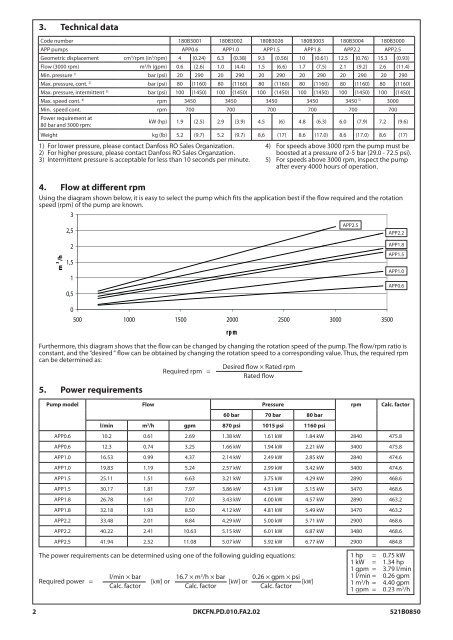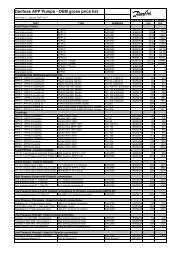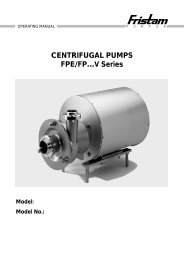data sheet
data sheet
data sheet
Create successful ePaper yourself
Turn your PDF publications into a flip-book with our unique Google optimized e-Paper software.
3. Technical <strong>data</strong><br />
Code number 180B3001 180B3002 180B3026 180B3003 180B3004 180B3000<br />
APP pumps APP0.6 APP1.0 APP1.5 APP1.8 APP2.2 APP2.5<br />
Geometric displacement cm 3 /rpm (in 3 /rpm) 4 (0.24) 6.3 (0.38) 9.3 (0.56) 10 (0.61) 12.5 (0.76) 15.3 (0.93)<br />
Flow (3000 rpm) m 3 /h (gpm) 0.6 (2.6) 1.0 (4.4) 1.5 (6.6) 1.7 (7.5) 2.1 (9.2) 2.6 (11.4)<br />
Min. pressure 1) bar (psi) 20 290 20 290 20 290 20 290 20 290 20 290<br />
Max. pressure, cont. 2) bar (psi) 80 (1160) 80 (1160) 80 (1160) 80 (1160) 80 (1160) 80 (1160)<br />
Max. pressure, intermittent 3) bar (psi) 100 (1450) 100 (1450) 100 (1450) 100 (1450) 100 (1450) 100 (1450)<br />
Max. speed cont. 4) rpm 3450 3450 3450 3450 3450 5) 3000<br />
Min. speed cont. rpm 700 700 700 700 700 700<br />
Power requirement at<br />
80 bar and 3000 rpm:<br />
kW (hp) 1.9 (2.5) 2.9 (3.9) 4.5 (6) 4.8 (6.3) 6.0 (7.9) 7.2 (9.6)<br />
Weight kg (lb) 5.2 (9.7) 5.2 (9.7) 8,6 (17) 8.6 (17.0) 8.6 (17.0) 8.6 (17)<br />
1) For lower pressure, please contact Danfoss RO Sales Organization. 4) For speeds above 3000 rpm the pump must be<br />
2) For higher pressure, please contact Danfoss RO Sales Organzation. boosted at a pressure of 2-5 bar (29.0 - 72.5 psi).<br />
3) Intermittent pressure is acceptable for less than 10 seconds per minute. 5) For speeds above 3000 rpm, inspect the pump<br />
after every 4000 hours of operation.<br />
4. Flow at different rpm<br />
Using the diagram shown below, it is easy to select the pump which fits the application best if the flow required and the rotation<br />
speed (rpm) of the pump are known.<br />
3<br />
2,5<br />
APP2.5<br />
APP2.2<br />
m 3 /h<br />
2<br />
1,5<br />
1<br />
0,5<br />
APP1.8<br />
APP1.5<br />
APP1.0<br />
APP0.6<br />
0<br />
500 1000 1500 2000 2500 3000 3500<br />
Furthermore, this diagram shows that the flow can be changed by changing the rotation speed of the pump. The flow/rpm ratio is<br />
constant, and the “desired “ flow can be obtained by changing the rotation speed to a corresponding value. Thus, the required rpm<br />
can be determined as:<br />
Desired flow × Rated rpm<br />
Required rpm =<br />
Rated flow<br />
5. Power requirements<br />
Pump model Flow Pressure rpm Calc. factor<br />
60 bar 70 bar 80 bar<br />
l/min m 3 /h gpm 870 psi 1015 psi 1160 psi<br />
rp m<br />
APP0.6 10.2 0.61 2.69 1.38 kW 1.61 kW 1.84 kW 2840 475.8<br />
APP0.6 12.3 0.74 3.25 1.66 kW 1.94 kW 2.21 kW 3400 475.8<br />
APP1.0 16.53 0.99 4.37 2.14 kW 2.49 kW 2.85 kW 2840 474.6<br />
APP1.0 19.83 1.19 5.24 2.57 kW 2.99 kW 3.42 kW 3400 474.6<br />
APP1.5 25.11 1.51 6.63 3.21 kW 3.75 kW 4.29 kW 2890 468.6<br />
APP1.5 30.17 1.81 7.97 3.86 kW 4.51 kW 5.15 kW 3470 468.6<br />
APP1.8 26.78 1.61 7.07 3.43 kW 4.00 kW 4.57 kW 2890 463.2<br />
APP1.8 32.18 1.93 8.50 4.12 kW 4.81 kW 5.49 kW 3470 463.2<br />
APP2.2 33.48 2.01 8.84 4.29 kW 5.00 kW 5.71 kW 2900 468.6<br />
APP2.2 40.22 2.41 10.63 5.15 kW 6.01 kW 6.87 kW 3480 468.6<br />
APP2.5 41.94 2.52 11.08 5.07 kW 5.92 kW 6.77 kW 2900 484.8<br />
The power requirements can be determined using one of the following guiding equations:<br />
l/min × bar 16.7 × m 3 /h × bar 0.26 × gpm × psi<br />
Required power = [kW] or [kW] or [kW]<br />
Calc. factor Calc. factor Calc. factor<br />
1 hp = 0.75 kW<br />
1 kW = 1.34 hp<br />
1 gpm = 3.79 l/min<br />
1 l/min = 0.26 gpm<br />
1 m 3 /h = 4.40 gpm<br />
1 gpm = 0.23 m 3 /h<br />
DKCFN.PD.010.FA2.02 521B0850






